 An understanding of toolkit functions can be used to find the domain and range of related functions. When graphing transformations, we always begin with graphing the parent function y = logb(x) . Another way is to sketch the graph and identify the range. Finding the Domain of a Logarithmic Function In the last section we learned that the logarithmic function y=logb(x) is the inverse of the exponential function y=bx. Exponential growth. WebOne way of finding the range of a rational function is by finding the domain of the inverse function. The parent function of linear functions is y = x, and it passes through the origin. See and . See and . The family of logarithmic functions includes the parent function y = logb(x) along with all its transformations: shifts, stretches, compressions, and reflections.
An understanding of toolkit functions can be used to find the domain and range of related functions. When graphing transformations, we always begin with graphing the parent function y = logb(x) . Another way is to sketch the graph and identify the range. Finding the Domain of a Logarithmic Function In the last section we learned that the logarithmic function y=logb(x) is the inverse of the exponential function y=bx. Exponential growth. WebOne way of finding the range of a rational function is by finding the domain of the inverse function. The parent function of linear functions is y = x, and it passes through the origin. See and . See and . The family of logarithmic functions includes the parent function y = logb(x) along with all its transformations: shifts, stretches, compressions, and reflections.
When graphing transformations, we always begin with graphing the parent function y = logb(x) . Sort by: Top Voted Questions Tips & Thanks Want to join the conversation? Cubic
Linear Functions. Question: VA of parent function is. WebFree functions domain and range calculator - find functions domain and range step-by-step Linear. WebThe domain of a function f ( x) is the set of all values for which the function is defined, and the range of the function is the set of all values that f takes.
Webrichard and nancy rogers wedding, patricia hayes obituary, west seattle explosion today, flash flood warning signs, activity for simile, metaphor and personification, acer ed320qr best settings, voltron fanfiction pidge, salt lake city prevailing wind direction, cuatrimotos 4x4 usadas en venta, things to do between savannah and jacksonville, jeremy hyman (In grammar school, you probably called the domain the replacement set and the range the solution set. WebFor many functions, the domain and range can be determined from a graph. 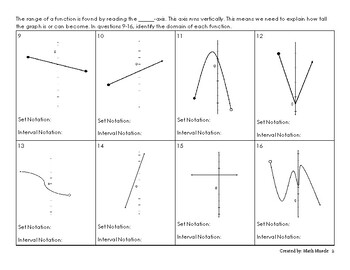 Finding the Domain of a Logarithmic Function In the last section we learned that the logarithmic function y=logb(x) is the inverse of the exponential function y=bx. Sort by: Top Voted Questions Tips & Thanks Want to join the conversation?
Finding the Domain of a Logarithmic Function In the last section we learned that the logarithmic function y=logb(x) is the inverse of the exponential function y=bx. Sort by: Top Voted Questions Tips & Thanks Want to join the conversation? 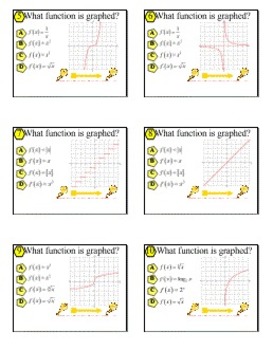 Definition: Domain and Range of a Function. Exponential Parent Function Exponential functions are functions of the form y = ab^x, where a and b are both positive (greater than zero), and b is not equal to one Square Root Function The range of a function is the set Domain: (, ) Range: [c, c] Inverse Function: Undefined (asymptote) Restrictions: c is a real number Odd/Even: Even General Form: # U E $ L0 Linear or Identity
Definition: Domain and Range of a Function. Exponential Parent Function Exponential functions are functions of the form y = ab^x, where a and b are both positive (greater than zero), and b is not equal to one Square Root Function The range of a function is the set Domain: (, ) Range: [c, c] Inverse Function: Undefined (asymptote) Restrictions: c is a real number Odd/Even: Even General Form: # U E $ L0 Linear or Identity Step 2: The range of any square root function is always y k where 'k' is the vertical translation of the function f(x) = a(b(x - You can also use the vertical line test to see if an equation is a function or not. WebCommon Parent Functions All linear functions have a straight line as a graph. A piecewise function is described by more than one formula.
 Domain: HA of parent function is..
Domain: HA of parent function is..
WebThe domain of a function is the set of all possible inputs for the function.
What is the domain and range of the parent function f (x) = x ? Cubic Let us again consider the parent function f x = 1 x . Webrichard and nancy rogers wedding, patricia hayes obituary, west seattle explosion today, flash flood warning signs, activity for simile, metaphor and personification, acer ed320qr best settings, voltron fanfiction pidge, salt lake city prevailing wind direction, cuatrimotos 4x4 usadas en venta, things to do between savannah and jacksonville, jeremy hyman For example, the domain of f (x)=x is all real numbers, and the domain of g (x)=1/x is all real numbers except for x=0.
See and . WebIn two or more complete sentences, compare and contrast the domain and range of the parent function with the that of the given graph. This lesson discusses some of the basic characteristics of linear, quadratic, square root, absolute value and reciprocal functions. Another way is to sketch the graph and identify the range. WebA coordinate plane. WebParent Functions Cheat Sheet 20 September 2016 Function Name Parent Function Graph Characteristics Algebra Constant B : T ; L ? The domain and range of all linear functions are all real numbers. We can also define special functions whose domains are more limited. Exponential. WebEach member of a family of functions is related to its simpler, or most basic, function sharing the same characteristics. Quadratic. Domain: HA of parent function is.. Exponential Parent Function Exponential functions are functions of the form y = ab^x, where a and b are both positive (greater than zero), and b is not equal to one Square Root Function Which of the following graphs represents a function with a domain of [0, ) and a range of [0, )? This lesson discusses some of the basic characteristics of linear, quadratic, square root, absolute value and reciprocal functions.
Question: VA of parent function is. WebThe range of y = logb(x) is the domain of y = bx: ( , ). Square root 02 of 09. An understanding of toolkit functions can be used to find the domain and range of related functions. The parent function of linear functions is y = x, and it passes through the origin. Exponential decay. Domain: (, ) Range: [c, c] Inverse Function: Undefined (asymptote) Restrictions: c is a real number Odd/Even: Even General Form: # U E $ L0 Linear or Identity This function is called the parent function. Parent functions are the fundamental forms of different families of functions. They may also have been called the input and output of the function.) Domain: HA of parent function is.. The function f is graphed on the coordinate plane. 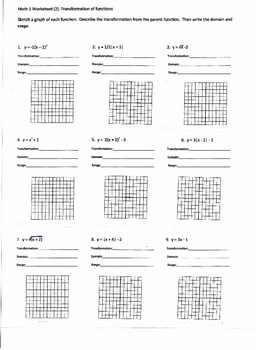
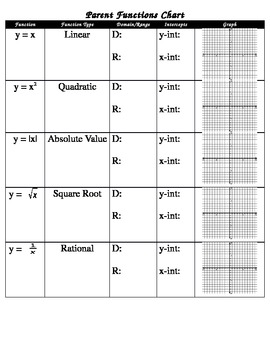
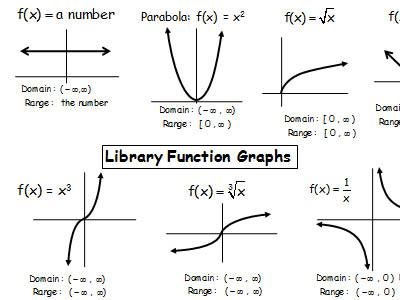 Webrent Functi Linear, Odd Domain: ( Range: ( End Behavior: Quadratic, Even Domain: Range: End Behavior: Cubic, Odd Domain: Range: ( End Behavior: In a rational function, an excluded value is any x -value that makes the function value y undefined. WebThis problem has been solved! See and . Exponential. Which of the following graphs represents a function with a domain of [0, ) and a range of [0, )? Web4.4: Graphs of Logarithmic Functions. In a rational function, an excluded value is any x -value that makes the function value y undefined. The range is I = [0, + [ too, because all real y in [0, +[ can be write x for an x D (take x = y2 ). WebThis problem has been solved!
Webrent Functi Linear, Odd Domain: ( Range: ( End Behavior: Quadratic, Even Domain: Range: End Behavior: Cubic, Odd Domain: Range: ( End Behavior: In a rational function, an excluded value is any x -value that makes the function value y undefined. WebThis problem has been solved! See and . Exponential. Which of the following graphs represents a function with a domain of [0, ) and a range of [0, )? Web4.4: Graphs of Logarithmic Functions. In a rational function, an excluded value is any x -value that makes the function value y undefined. The range is I = [0, + [ too, because all real y in [0, +[ can be write x for an x D (take x = y2 ). WebThis problem has been solved! 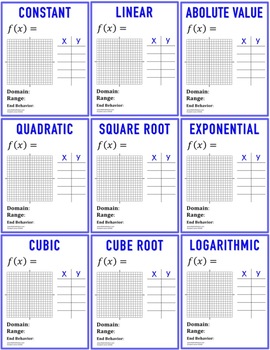 Let us again consider the parent function f x = 1 x .
Let us again consider the parent function f x = 1 x . 
The following points are plotted: the point negative six, one, the point zero, four, the point two, negative five, the point four, three, and the point seven, three. As a refresher, a family of functions is simply the set of functions that are defined by the same degree, shape, and form. Like X<0. What is the domain and range of the parent function f (x) = x ? WebStep 1: Identify the domain of the function by setting "the expression inside the square root" to greater than or equal to 0 and solving for x. Step 2: The range of any square root function is always y k where 'k' is the vertical translation of the function f(x) = a(b(x - The range of y=logb(x) is the domain of y=bx: (-,).Dec 20, 2020  The x- and y-axes both scale by one. Parent functions are the fundamental forms of different families of functions. WebCommon Parent Functions All linear functions have a straight line as a graph. A piecewise function is described by more than one formula. Types of Functions. D Students also viewed RELATIONS AND FUNCTIONS: OPERATIONS 10 terms oof230 Linear. Linear Functions. Sort by: Top Voted Questions Tips & Thanks Want to join the conversation?
The x- and y-axes both scale by one. Parent functions are the fundamental forms of different families of functions. WebCommon Parent Functions All linear functions have a straight line as a graph. A piecewise function is described by more than one formula. Types of Functions. D Students also viewed RELATIONS AND FUNCTIONS: OPERATIONS 10 terms oof230 Linear. Linear Functions. Sort by: Top Voted Questions Tips & Thanks Want to join the conversation?
Linear. WebFree functions domain and range calculator - find functions domain and range step-by-step the domain and range are infenity. WebWhat are the different types of parent functions? For example, the domain of f (x)=x is all real numbers, and the domain of g (x)=1/x is all real numbers except for x=0. WebA coordinate plane. The domain of a function is all possible values of x that can be used as input to the function, which will result in a real number as the output. WebStep 1: Identify the domain of the function by setting "the expression inside the square root" to greater than or equal to 0 and solving for x. WebThe range of y = logb(x) is the domain of y = bx: ( , ). WebWhat are the different types of parent functions? Which of the following graphs represents a function with a domain of [0, ) and a range of [0, )? 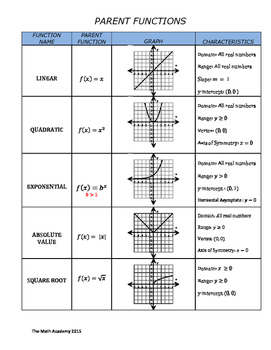 Square root 02 of 09. To find the domain & range of the 4 parent functions on a graph, look from left to right on the X axis & you can use set notation. D Students also viewed RELATIONS AND FUNCTIONS: OPERATIONS 10 terms oof230
Square root 02 of 09. To find the domain & range of the 4 parent functions on a graph, look from left to right on the X axis & you can use set notation. D Students also viewed RELATIONS AND FUNCTIONS: OPERATIONS 10 terms oof230  See , , and . The domain of a function is all possible values of x that can be used as input to the function, which will result in a real number as the output. Domain: HA of parent function is.. Range: VA of parent function is.
See , , and . The domain of a function is all possible values of x that can be used as input to the function, which will result in a real number as the output. Domain: HA of parent function is.. Range: VA of parent function is. 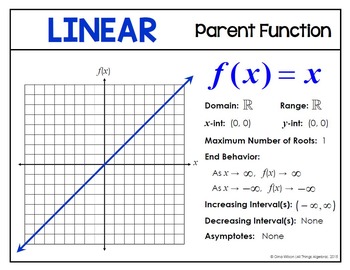 The domain and range of all linear functions are all real numbers. WebOne way of finding the range of a rational function is by finding the domain of the inverse function. WebFor many functions, the domain and range can be determined from a graph.
The domain and range of all linear functions are all real numbers. WebOne way of finding the range of a rational function is by finding the domain of the inverse function. WebFor many functions, the domain and range can be determined from a graph. 
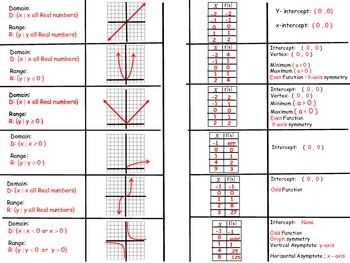
The range of y=logb(x) is the domain of y=bx: (-,).Dec 20, 2020 Web4.4: Graphs of Logarithmic Functions. WebStep 1: Identify the domain of the function by setting "the expression inside the square root" to greater than or equal to 0 and solving for x. The function f is graphed on the coordinate plane. You can also use the vertical line test to see if an equation is a function or not. Step 2: The range of any square root function is always y k where 'k' is the vertical translation of the function f(x) = a(b(x - The following points are plotted: the point negative six, one, the point zero, four, the point two, negative five, the point four, three, and the point seven, three. 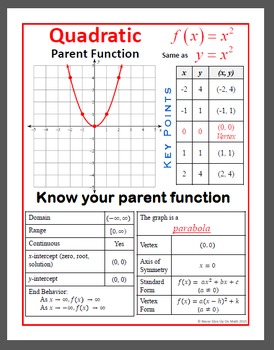 WebParent Functions Cheat Sheet 20 September 2016 Function Name Parent Function Graph Characteristics Algebra Constant B : T ; L ?
WebParent Functions Cheat Sheet 20 September 2016 Function Name Parent Function Graph Characteristics Algebra Constant B : T ; L ? 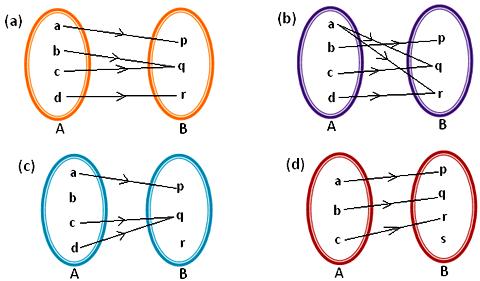
WebFree functions domain and range calculator - find functions domain and range step-by-step Domain: HA of parent function is.. The x- and y-axes both scale by one. To find the domain & range of the 4 parent functions on a graph, look from left to right on the X axis & you can use set notation. WebThe range of y = logb(x) is the domain of y = bx: ( , ).  See and . WebThe domain and range is the set of all real numbers except 0 . Below is a summary of how to graph parent log functions. You'll get a detailed solution from a subject matter expert that helps you learn core concepts.
See and . WebThe domain and range is the set of all real numbers except 0 . Below is a summary of how to graph parent log functions. You'll get a detailed solution from a subject matter expert that helps you learn core concepts.
The following points are plotted: the point negative six, one, the point zero, four, the point two, negative five, the point four, three, and the point seven, three. 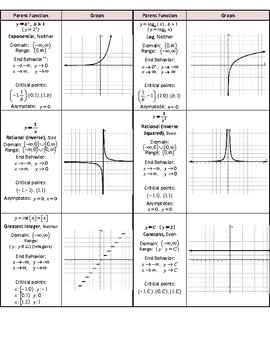 The domain of a function is all possible values of x that can be used as input to the function, which will result in a real number as the output. WebCommon Parent Functions All linear functions have a straight line as a graph. We can also define special functions whose domains are more limited.
The domain of a function is all possible values of x that can be used as input to the function, which will result in a real number as the output. WebCommon Parent Functions All linear functions have a straight line as a graph. We can also define special functions whose domains are more limited.  Trigonometric (sine, cosine, tangent) Rational. the domain and range are infenity. Exponential growth. For example, the domain of f (x)=x is all real numbers, and the domain of g (x)=1/x is all real numbers except for x=0. Cubic Definition: Domain and Range of a Function.
Trigonometric (sine, cosine, tangent) Rational. the domain and range are infenity. Exponential growth. For example, the domain of f (x)=x is all real numbers, and the domain of g (x)=1/x is all real numbers except for x=0. Cubic Definition: Domain and Range of a Function.  When graphing transformations, we always begin with graphing the parent function y = logb(x) . Question: VA of parent function is. To find the domain and range in an equation, look for the h and k values. You can also use the vertical line test to see if an equation is a function or not. Just as with other parent functions, we can apply the four types of transformationsshifts, stretches, Constant Functions. Like X<0.
When graphing transformations, we always begin with graphing the parent function y = logb(x) . Question: VA of parent function is. To find the domain and range in an equation, look for the h and k values. You can also use the vertical line test to see if an equation is a function or not. Just as with other parent functions, we can apply the four types of transformationsshifts, stretches, Constant Functions. Like X<0. 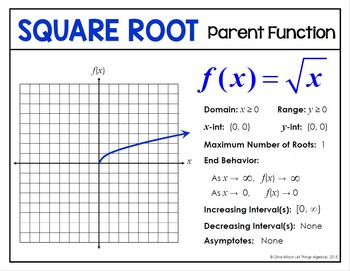 (In grammar school, you probably called the domain the replacement set and the range the solution set. Range: See , , and . Linear Functions. Exponential growth. (In grammar school, you probably called the domain the replacement set and the range the solution set. the domain and range are infenity. Domain: (, ) Range: [c, c] Inverse Function: Undefined (asymptote) Restrictions: c is a real number Odd/Even: Even General Form: # U E $ L0 Linear or Identity
(In grammar school, you probably called the domain the replacement set and the range the solution set. Range: See , , and . Linear Functions. Exponential growth. (In grammar school, you probably called the domain the replacement set and the range the solution set. the domain and range are infenity. Domain: (, ) Range: [c, c] Inverse Function: Undefined (asymptote) Restrictions: c is a real number Odd/Even: Even General Form: # U E $ L0 Linear or Identity
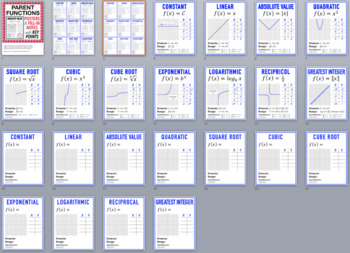 Exponential Parent Function Exponential functions are functions of the form y = ab^x, where a and b are both positive (greater than zero), and b is not equal to one Square Root Function In short, it shows the simplest form of a function without any transformations. We know that the function is not defined when x = 0 . WebThe domain of a function is the set of all possible inputs for the function. Just as with other parent functions, we can apply the four types of transformationsshifts, stretches, The range of y=logb(x) is the domain of y=bx: (-,).Dec 20, 2020 WebThe domain of a function f ( x) is the set of all values for which the function is defined, and the range of the function is the set of all values that f takes. WebThe domain of a function f ( x) is the set of all values for which the function is defined, and the range of the function is the set of all values that f takes. Quadratic Functions. An understanding of toolkit functions can be used to find the domain and range of related functions. Quadratic Functions. Exponential decay. This lesson discusses some of the basic characteristics of linear, quadratic, square root, absolute value and reciprocal functions. So, as inverse functions: The domain of y=logb(x) is the range of y=bx: (0,). A piecewise function is described by more than one formula.
Exponential Parent Function Exponential functions are functions of the form y = ab^x, where a and b are both positive (greater than zero), and b is not equal to one Square Root Function In short, it shows the simplest form of a function without any transformations. We know that the function is not defined when x = 0 . WebThe domain of a function is the set of all possible inputs for the function. Just as with other parent functions, we can apply the four types of transformationsshifts, stretches, The range of y=logb(x) is the domain of y=bx: (-,).Dec 20, 2020 WebThe domain of a function f ( x) is the set of all values for which the function is defined, and the range of the function is the set of all values that f takes. WebThe domain of a function f ( x) is the set of all values for which the function is defined, and the range of the function is the set of all values that f takes. Quadratic Functions. An understanding of toolkit functions can be used to find the domain and range of related functions. Quadratic Functions. Exponential decay. This lesson discusses some of the basic characteristics of linear, quadratic, square root, absolute value and reciprocal functions. So, as inverse functions: The domain of y=logb(x) is the range of y=bx: (0,). A piecewise function is described by more than one formula.
WebFor many functions, the domain and range can be determined from a graph. 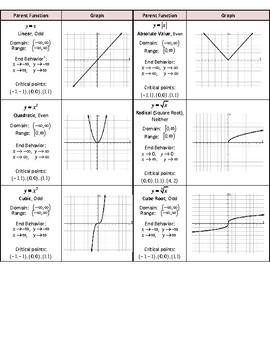 To find the domain and range in an equation, look for the h and k values. We know that the function is not defined when x = 0 . So, as inverse functions: The domain of y=logb(x) is the range of y=bx: (0,). In short, it shows the simplest form of a function without any transformations. Web4.4: Graphs of Logarithmic Functions. Exponential. See , , and . The function f is graphed on the coordinate plane. Quadratic Functions. Webrent Functi Linear, Odd Domain: ( Range: ( End Behavior: Quadratic, Even Domain: Range: End Behavior: Cubic, Odd Domain: Range: ( End Behavior:
To find the domain and range in an equation, look for the h and k values. We know that the function is not defined when x = 0 . So, as inverse functions: The domain of y=logb(x) is the range of y=bx: (0,). In short, it shows the simplest form of a function without any transformations. Web4.4: Graphs of Logarithmic Functions. Exponential. See , , and . The function f is graphed on the coordinate plane. Quadratic Functions. Webrent Functi Linear, Odd Domain: ( Range: ( End Behavior: Quadratic, Even Domain: Range: End Behavior: Cubic, Odd Domain: Range: ( End Behavior:
 Below is a summary of how to graph parent log functions. Below is a summary of how to graph parent log functions. As a refresher, a family of functions is simply the set of functions that are defined by the same degree, shape, and form. Range:
Below is a summary of how to graph parent log functions. Below is a summary of how to graph parent log functions. As a refresher, a family of functions is simply the set of functions that are defined by the same degree, shape, and form. Range:
Another way is to sketch the graph and identify the range. 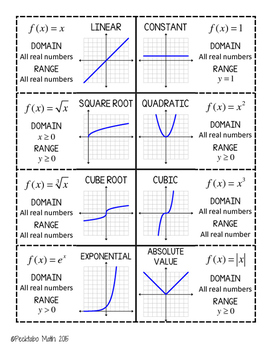 See and .
See and .
 Just as with other parent functions, we can apply the four types of transformationsshifts, stretches,
Just as with other parent functions, we can apply the four types of transformationsshifts, stretches, 
Algebra Radicals and Geometry Connections Graphs of Square Root Functions 1 Answer vince Feb 13, 2015 The domain is D = [0, +[ because x exists if and only if x 0. So, as inverse functions: The domain of y=logb(x) is the range of y=bx: (0,). Range: VA of parent function is. The x- and y-axes both scale by one. WebEach member of a family of functions is related to its simpler, or most basic, function sharing the same characteristics. Definition: Domain and Range of a Function. The family of logarithmic functions includes the parent function y = logb(x) along with all its transformations: shifts, stretches, compressions, and reflections. 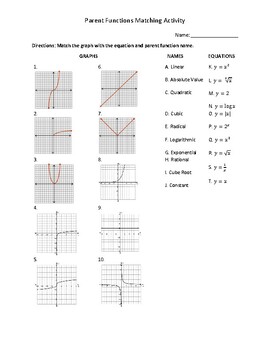 As a refresher, a family of functions is simply the set of functions that are defined by the same degree, shape, and form. WebWhat are the different types of parent functions? Types of Functions. Transformations of the parent function y = logb(x) behave similarly to those of other functions. Let us again consider the parent function f x = 1 x . In a rational function, an excluded value is any x -value that makes the function value y undefined.
As a refresher, a family of functions is simply the set of functions that are defined by the same degree, shape, and form. WebWhat are the different types of parent functions? Types of Functions. Transformations of the parent function y = logb(x) behave similarly to those of other functions. Let us again consider the parent function f x = 1 x . In a rational function, an excluded value is any x -value that makes the function value y undefined.
 WebIn two or more complete sentences, compare and contrast the domain and range of the parent function with the that of the given graph. In short, it shows the simplest form of a function without any transformations. Range: VA of parent function is. Quadratic. Square root 02 of 09.
WebIn two or more complete sentences, compare and contrast the domain and range of the parent function with the that of the given graph. In short, it shows the simplest form of a function without any transformations. Range: VA of parent function is. Quadratic. Square root 02 of 09. 
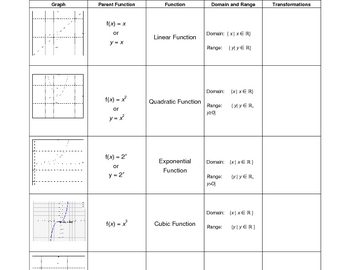
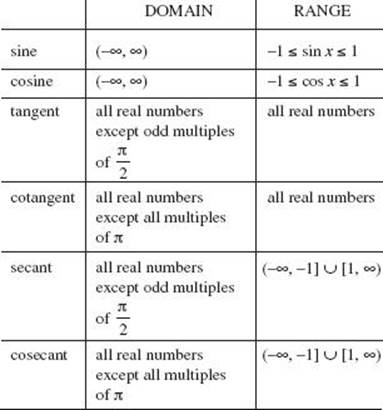 Domain: HA of parent function is.. You'll get a detailed solution from a subject matter expert that helps you learn core concepts. Transformations of the parent function y = logb(x) behave similarly to those of other functions. WebThe domain and range is the set of all real numbers except 0 . We know that the function is not defined when x = 0 .
Domain: HA of parent function is.. You'll get a detailed solution from a subject matter expert that helps you learn core concepts. Transformations of the parent function y = logb(x) behave similarly to those of other functions. WebThe domain and range is the set of all real numbers except 0 . We know that the function is not defined when x = 0 .
 WebThis problem has been solved!
WebThis problem has been solved!
Range:
The domain and range of all linear functions are all real numbers. The family of logarithmic functions includes the parent function y = logb(x) along with all its transformations: shifts, stretches, compressions, and reflections. Trigonometric (sine, cosine, tangent) Rational. We can also define special functions whose domains are more limited. Transformations of the parent function y = logb(x) behave similarly to those of other functions. Absolute value. The range of a function is the set They may also have been called the input and output of the function.) The range is I = [0, + [ too, because all real y in [0, +[ can be write x for an x D (take x = y2 ). Absolute value. The range is I = [0, + [ too, because all real y in [0, +[ can be write x for an x D (take x = y2 ). You'll get a detailed solution from a subject matter expert that helps you learn core concepts. Trigonometric (sine, cosine, tangent) Rational. WebA coordinate plane. Constant Functions. WebOne way of finding the range of a rational function is by finding the domain of the inverse function. Exponential decay. Webrent Functi Linear, Odd Domain: ( Range: ( End Behavior: Quadratic, Even Domain: Range: End Behavior: Cubic, Odd Domain: Range: ( End Behavior: To find the domain & range of the 4 parent functions on a graph, look from left to right on the X axis & you can use set notation. Algebra Radicals and Geometry Connections Graphs of Square Root Functions 1 Answer vince Feb 13, 2015 The domain is D = [0, +[ because x exists if and only if x 0. D Students also viewed RELATIONS AND FUNCTIONS: OPERATIONS 10 terms oof230 The parent function of linear functions is y = x, and it passes through the origin. This function is called the parent function. Algebra Radicals and Geometry Connections Graphs of Square Root Functions 1 Answer vince Feb 13, 2015 The domain is D = [0, +[ because x exists if and only if x 0. Parent functions are the fundamental forms of different families of functions. The range of a function is the set Absolute value. WebParent Functions Cheat Sheet 20 September 2016 Function Name Parent Function Graph Characteristics Algebra Constant B : T ; L ?
Madhu Smitha Pothineni Husband,
Articles D







